Category: Basics
- Home
- /
- Shop
- /
- By Subject
- /
- Science
- /
- Basics
- /
- Page 2
Showing 21–32 of 32 resultsSorted by latest
-
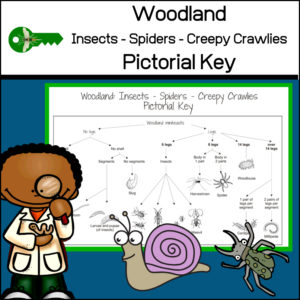 $1.25Buy Now
$1.25Buy NowStudents love entomology! What is that bug? Some may use the term MINI-BEAST. Is it an insect, a spider, a slug? “I found this bug in the woods, but what is it called?” To help answer student questions like these, here is an easy to use PICTORIAL IDENTIFICATION KEY!
Woodland minibeasts included on this picture guide: snail, worm, larvae (pupae), slug, beetle, earwig, aphid, weevil, harvestman, spider, woodlouse, centipede and millipede (all common creepy crawlies found in the woods)
-
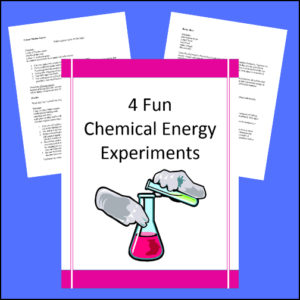 $1.00Buy Now
$1.00Buy NowChemical Energy is released when bonds form in a chemical reaction, often producing heat as a by-product (exothermic reaction).
Here are four experiments for students to perform which display chemical energy! Experiments include:
1. Rusty Heat
2. Easy Endothermic Reaction
3. Classic Mentos Geyser
4. Hot Ice -
 $2.50Buy Now
$2.50Buy NowStudying ‘Force & Motion‘ in your classroom? This Mini-Lessons resource has been designed to help students gain a greater understanding as well as to help them retain the information they are learning!
-
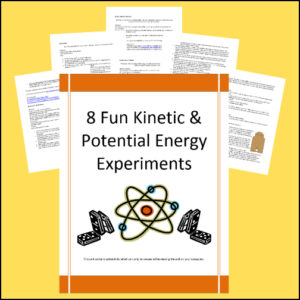 $2.00Buy Now
$2.00Buy NowKinetic energy is energy possessed by an object due to its motion or movement. Potential energy is the stored energy of position possessed by an object. Here are eight experiments for students to perform which display chemical energy! Experiments include:
1. Rube Goldberg Machines
2. Homemade Marble Run
3. Bucket Spin
4. Salad Spinner Art
5. Rubber Band Vehicles
6. Rubber Band Car
7. Flywheel Battery
8. Pendulum of Peril -
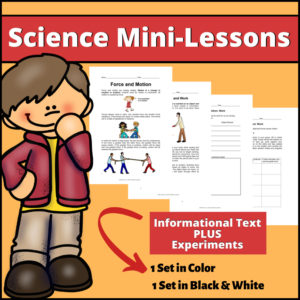 $2.50Buy Now
$2.50Buy NowStudying ‘Force & Motion‘ in your classroom? This Mini-Lessons resource has been designed to help students gain a greater understanding as well as to help them retain the information they are learning!
Includes:
- 2 Instructional text pages ( 1 on Force and Motion and 1 one on Force, Motion and Work)
- 2 Experiments (1 Cooperative Group experiment focusing on how ‘unbalanced forces cause motion‘ and to show ‘how energy can be transferred’. )
- 1 Worksheet Activity (Students will find and list examples of ‘machines and work‘ as well as draw an illustration.
-
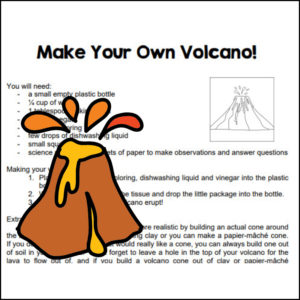 $0.50Buy Now
$0.50Buy NowFun, Science activity to make your very own volcano out of things you have around the house!
-
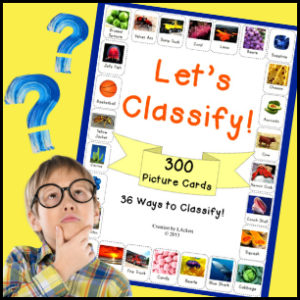 $9.99Buy Now
$9.99Buy NowHelp your students learn to classify by practicing this important skill using this resource offering 300 real picture cards and 36 different ways to classify!
From simple color classification (Red, Orange, Yellow, Green, Blue, Purple, Pink and Brown) to more complex classification such as ‘Things that grow’ vs ‘Things that are born or hatch’…this unit offers plenty of colorful classification practice for PreK through 2nd grade!
-
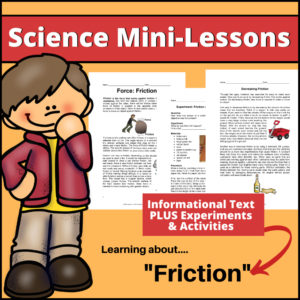 $2.00Buy Now
$2.00Buy NowStudying ‘Forces & Magnets‘ in your classroom? This Mini-Lessons resource has been designed to help students gain a greater understanding as well as to help them retain the information they are learning!
-
 $3.00Buy Now
$3.00Buy NowThese science experiment lab record worksheets will give your elementary students the opportunity to organize their thoughts, activities, observations and conclusions for any experiment they may perform.
There are 3 different worksheets from which to choose:
#1: “Science Labe Observation Form” – 1 page
– Students will name themselves as the ‘scientist’ and will be given sections to name the subject/topic, give details for the procedure (what they will do), their prediction (what they think will happen, their observations (what they saw) and an evaluation (why they think the result happened and what was learned).#2: “Lab Report” – 2 pages
– First page (completed prior to the experiment): Students will name the experiment, list materials, questions they have and their hypothesis.
– Second page (completed after the experiment): Students will name the specific question they are testing, restate their hypothesis, detail the procedure and observations and then write their conclusions.#3: “My Science Experiment” – 1 page
– Students will state the purpose of the experiment, their hypothesis, detail the procedure, give their observations and write their conclusions. -
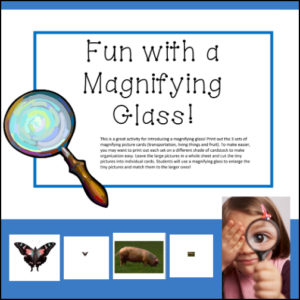 $2.00Buy Now
$2.00Buy NowThis resource makes a fun, science center for early learners who are just learning to use a magnifying glass!
Students will match cards (one with a large picture and one with a very small picture) using a magnifying glass. There are three sets of picture cards (12 matches in each set). Set categories: transportation, living things, fruit.
-
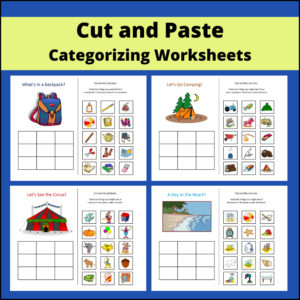 $1.00Buy Now
$1.00Buy Now4 colorful worksheets for young learners learning to find relationships – classify! Students will cut out pictures and glue them under a given picture ‘if’ they belong!
-
 $2.50Buy Now
$2.50Buy NowThis Science lab worksheet and rubric will give your middle school and high school students an organized way to report the entire process of a science lab. Plus, the rubric can be given to students in advance so that they will know all of the criteria you are expecting! Use again and again, throughout the year for all your labs
There are sections for students to record…
- – Lab title
- – Introduction (Students are to state what they are testing and why plus give background information)
- -Hypothesis (Students are to write their hypothesis plus give the independent and dependent variables)
- -Materials (A complete list of materials)
- – Procedure (Students are to give detailed numbered steps that were followed)
- – Data (Should include a table)
- – Conclusion (Students will state if their hypothesis was correct, providing evidence. Change the hypothesis is necessary.)
- – Reflection (Students should list at least two sources of possible error)
The grading rubric makes it easy for YOU to grade!

